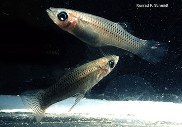pms
nòm ant ël fil


Gambusia rhizophorae és un peix de la família dels pecílids i de l'ordre dels ciprinodontiformes.
Els mascles poden assolir els 5 cm de longitud total.[2]
Es troba a Florida (Estats Units) i Cuba.[3]
Gambusia rhizophorae és un peix de la família dels pecílids i de l'ordre dels ciprinodontiformes.
The Mangrove gambusia (Gambusia rhizophorae) is a tropical poeciliid (live bearing) fish species with a restricted, disjunct range one in northwestern Cuba, the other in southeastern Florida.[3] The Florida population has been recently listed as "biologically vulnerable" (vulnerable to extinction because of the taxon’s biology or other indicators) by the Florida Fish and Wildlife Conservation Commission.
The Mangrove gambusia is a brackish fish, typically a resident of sheltered mangrove forests. In Florida, the species is distributed from Fort Lauderdale, south along the mainland coast, and throughout the Florida Keys to Key West. Its distribution in Florida appears to be temperature limited (Getter, 1982). The exact location of the Cuban population is being examined to allow a map of its distribution to be produced.
Habitat destruction for development has reduced available habitats through loss of a number of mangrove forests and formerly occupied sites (Charles Getter, 1976) in Florida. Also contributing to biological vulnerability is the species' limited habitat, temperature restrictions, and hybridization with other species throughout its range (Charles Getter, 1976). One of the largest populations known for the Mangrove gambusia was the lush 100+ acre mangrove forest known as the "Cocoplum Islands" that was developed into the Cocoplum Development in the mid-1970s.
Ongoing research is underway by Dr. Charles Getter, who has studied the species since the 1970s.
 Female above, male below.
Female above, male below. The Mangrove gambusia (Gambusia rhizophorae) is a tropical poeciliid (live bearing) fish species with a restricted, disjunct range one in northwestern Cuba, the other in southeastern Florida. The Florida population has been recently listed as "biologically vulnerable" (vulnerable to extinction because of the taxon’s biology or other indicators) by the Florida Fish and Wildlife Conservation Commission.
Gambusia rhizophorae es un pez de la familia de los pecílidos en el orden de los ciprinodontiformes.
Los machos pueden alcanzar los 5 cm de longitud total.[2]
Se encuentran en Florida (Estados Unidos) y Cuba.[2]
Gambusia rhizophorae es un pez de la familia de los pecílidos en el orden de los ciprinodontiformes.
Gambusia rhizophorae Gambusia generoko animalia da. Arrainen barruko Poeciliidae familian sailkatzen da.
Gambusia rhizophorae Gambusia generoko animalia da. Arrainen barruko Poeciliidae familian sailkatzen da.
Gambusia rhizophorae is een straalvinnige vissensoort uit de familie van levendbarende tandkarpers (Poeciliidae).[1] De wetenschappelijke naam van de soort is voor het eerst geldig gepubliceerd in 1969 door Rivas.
Bronnen, noten en/of referenties曼格食蚊魚,為輻鰭魚綱鯉齒目鯉齒亞目花鳉科的其中一種,分布於北美洲美國佛羅里達州東南部及古巴的淡水、半鹹水流域,體長可達5公分,棲息河口、紅樹林,屬於肉食性,生活習性不明。